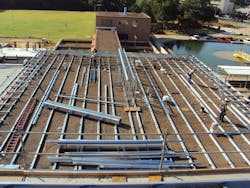Metal Roof Retrofits: the potential, the problems, the payoff, part 2
I left off my last post on retrofits looking for trouble….literally. Hidden problems can cause quite a bit of trouble if left undiscovered. And hidden problems with retrofitting a flat roof to a sloped roof often come in the form of H20.
Look out for moisture inside the existing roof membrane. Roof insulation tends to soak up moisture until the point of saturation, which can cause several problems:
- The compressive strength of the roof insulation may be compromised to the point it can no longer support the weight of the retrofit framework.
The fix: Remove the existing roof, down to the deck, at all retrofit framing attachment points. - Some roofing insulation, when saturated with water, forms an acidic solution. This solution can rapidly deteriorate a roof deck, particularly a metal deck. If the deck is corroded, it may be incapable of supporting the weight of the retrofit framework at the attachment points to the existing secondary structurals.
The fix: The existing deck must be removed at these points to allow the retrofit framework to rest directly upon the existing secondary structurals. - In severe cases the deck may be so badly deteriorated that it is no longer capable of laterally supporting the existing secondary structurals.
The fix: At this point, another means of laterally stabilizing the existing secondary structurals may be required.
Any time water is found inside the roof membrane, regardless of damage, the membrane should be "opened up” in numerous places after the retrofit roof is in place and a ventilation system installed to "dry out" the existing roof. Because of the possibility of an acidic solution being formed in the existing roof, always use a stainless steel fastener to attach the retrofit framework to the existing secondary structurals. Standard steel fasteners can rust away within a few years, leaving the retrofit roof unattached to the existing structure.
Check for asbestos. Government regulations concerning the removal or encapsulation of asbestos will add tremendously to the cost of any project.
Also, recognize that an "attic space" will be created by the retrofit roof. Be sure that local code, government and insurance regulations are met. ln some cases a sprinkler system or access door through the existing roof may be required.
So you know what the customer wants, what the customer has, and you’ve searched out hidden problems and have a plan to address them. I have two more steps you’ll want take to retrofit a metal roof successfully. Stay tuned.
Learn more about retrofit solutions and best practices by taking MBCI’s AIA-accrediated continuing education course, Retrofit Roof Systems. http://www.bdcuniversity.com/retrofit-roof-systems

